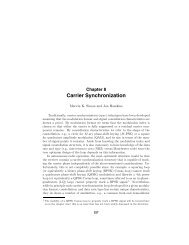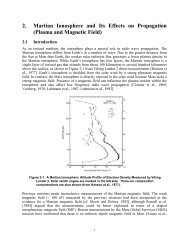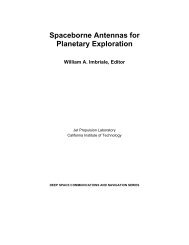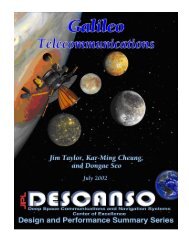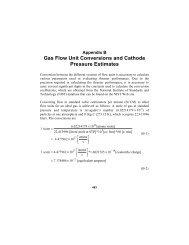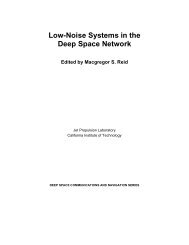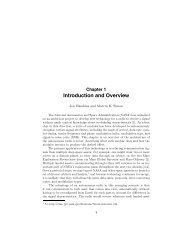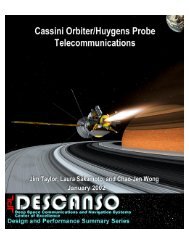Propagation Effects Handbook for Satellite Systems - DESCANSO ...
Propagation Effects Handbook for Satellite Systems - DESCANSO ...
Propagation Effects Handbook for Satellite Systems - DESCANSO ...
You also want an ePaper? Increase the reach of your titles
YUMPU automatically turns print PDFs into web optimized ePapers that Google loves.
6.5.2.2.3 Power Spectral Density. The <strong>for</strong>mulation of the structure<br />
of the power spectral density of turbulence-induced amplitude<br />
fluctuations has been derived from classical turbulence theory<br />
(Tatarski-1961) . The theoretical spectrum of amplitude fluctuations<br />
in a medium characterized by a real refractive index is found to<br />
roll off as ff-B13, or -26.6 dB/decade, in fluctuation frequency ff.<br />
This behavior is not a function of operating frequency, as long as<br />
the wavelength is small or on the order of the smallest refractive<br />
inhomogeneities. Deviation from this slope will occur due to nonstationarity<br />
of the scintillation process.<br />
The spectral slope was calculated <strong>for</strong> time records of 102,4<br />
seconds at 2 and 30 GHz on the ATS-6 CW beacons as the satellites<br />
moved in elevation angle from 0.38 to 25 degrees (Baxter and Hodge-<br />
1978) . Spectral slope was found to be essentially independent of<br />
equivalent path length and measured statistics were well centered<br />
about the theoretical value of -26 dB/decade. Figures 6.5-5a and b<br />
present the probability distribution functions of the 2 and 30 GHz<br />
spectral slopes, respectively. Figure 6.5-6 presents the worst-case<br />
confidence limits of distribution of spectral slope from an average<br />
-26.6 dB/decade, <strong>for</strong> 50% and 90% of total time. Such an estimate<br />
may be used to directly find the expected fading rates and spectral<br />
components due to turbulence-induced amplitude scintillation. The<br />
data represents clear air statistics over a period of 26 days.<br />
6.5.2.2.4 Estimation of Gain Degradation. The model <strong>for</strong> received<br />
signal amplitude variance has also been used to derive an expression<br />
<strong>for</strong> gain reduction, R, defined by (Theobold and Hedge - 1978)<br />
<br />
R = 10log10 ‘vd2>k@m@e fluctuation<br />
,. ,010910*<br />
1~ + Ii<br />
6-82<br />
*4<br />
(6.5-3)





